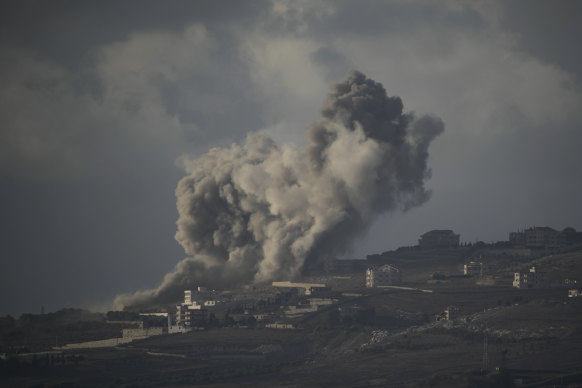This was published 8 months ago
Opinion
Iran tried to light a ring of fire around Israel. But now Israel wields the blowtorch
Peter Hartcher
Political and international editorThe Iranian ayatollah’s strategy from the outset was to light a “ring of fire” around Israel to burn it to death.
Hamas attacked Israel on October 7 and “the day after October 7 was the day Iran ignited the ring of fire”, says retired Australian army colonel Mike Kelly, a former Labor minister for defence materiel.
The ring has many parts to it and all flared up: Hamas and Palestinian Islamic Jihad in Gaza, Hezbollah in Lebanon, the Houthis in Yemen, Kataib Hezbollah in Iraq, just to name the biggest.

Israeli bombardment in Lebanon on Tuesday.Credit: AP
All are armed, financed and directed by Iran. For instance, as the late Hezbollah leader, Hassan Nasrallah, once said: “Hezbollah’s budget, everything it eats and drinks, its weapons and rockets, comes from the Islamic Republic of Iran.”
Or Hamas, whose military commander Yahya Sinwar said of his forces in 2017: “Relations with Iran are excellent and Iran is the largest supporter of the Izz ad Din al Qassam Brigades with money and arms.”
Iran’s strategy is shrewd. Why should Iran expose itself to Israeli attack when its armies of affiliates were only too happy to martyr themselves for the cause?
“A situation was created,” says former Mossad chief Tamir Pardo, “in which Iran had a border with Israel but Israel had no border with Iran, which is more than 1000 miles away.”
But the strategy is failing. Israel has inflicted so much damage on Iran’s proxies, has doused so much of the fire, that Iran finally felt compelled to engage the enemy itself.
“I don’t think Iran really wanted a war with Israel,” says ANU professor emeritus of Middle East studies, Amin Saikal.
“But Iran got to the point of saying to Israel, ‘No, you’re not going to agree to a ceasefire in Gaza, you’re invading Lebanon’, and at the same time Iran wanted to maintain its credibility and its network of affiliates.”
The result? Iran bombarded Israel with 180 ballistic missiles on Tuesday night, Australian time. After its missile and drone assault on Israel in April, this was only the second time Iran has struck Israel directly.
And, for the second time, while it terrified Israeli civilians, Iran’s missiles proved impotent against the combined interception effort of Israel, the United States, Britain, France and Jordan.
But instead of intensifying its attack, Iran has pulled back. It immediately declared its action complete.
It has many thousands more missiles that it could fire and possibly overwhelm Israel’s air defences, but it is not. Its air force has stayed on the ground. It is not threatening escalation or hinting at nuclear attack.
The regime of Ayatollah Khamenei is unpopular at home and its economy is crushed by sanctions imposed by the West. “Iran doesn’t want an all-out regional war because of the damage it would do to Iran but also damage it would do to the regime,” says retired Australian major general Mick Ryan.
But with the ring of fire sputtering and smouldering, Israel now confronts the chief arsonist in his own home. And Iran has given Israel the opportunity to impose a punishing retaliation.
“Netanyahu,” observes Ryan, “is also in regime-preservation mode.” He has promised to retaliate and, unlike in April, the White House this time is not urging restraint.
Israel “would love to attack” Iran’s nuclear development facilities attests Ryan, a military and political achievement that Netanyahu craves, “but whether they have reach is another question”.
With the ring of fire subdued and the arsonist exposed, Tehran is in a very vulnerable position as it awaits Israel’s next move.
Get a note directly from our foreign correspondents on what’s making headlines around the world. Sign up for our weekly What in the World newsletter.